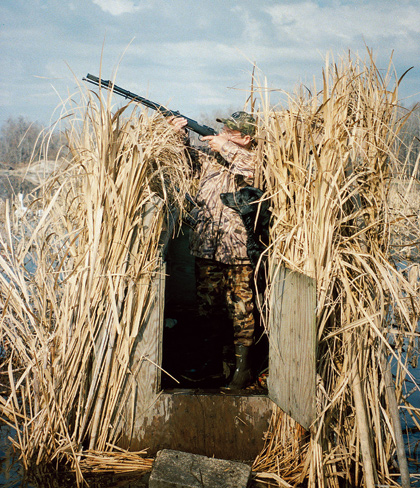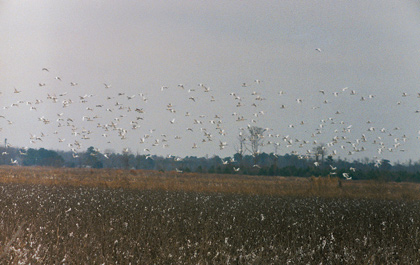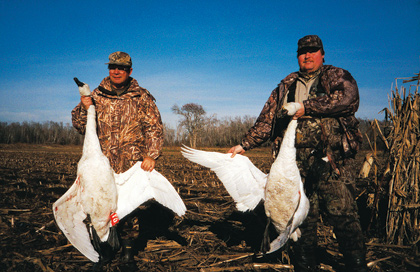November 03, 2010
By William Hovey Smith
Feather For Feather, There's Nothing Quite Like Swans
By William Hovey Smith
 Shooting the smoke pole from the blind as Meg, the retriever, looks on with good intesions. |
Swans are generally conceded to be the kings of North American waterfowl. The first time many duck hunters see sunset flights of swans returning to Lake Mattamuskeet, North Carolina, their supply of superlatives are quickly exhausted--even awesome, magnificent, stately and beautiful seem inadequate. The pink tints on the clouds and on the bird's wings supplemented by the swan's raucous calls are only a little short of breathtaking.
Swan hunting rightly has a place in the waterfowler's lexicon because a controlled harvest keeps them from expanding to the point where the aggressive birds deprive other species of feed and nesting sites. Old time guides at Lake Mattamuskeet called them "sky carp," because the 30,000 swans in the area consumed much of the grain planted for other waterfowl. Partly because of this moniker and their ready access to premium eating ducks like mallards and pintails, the locals unjustifiably distained swans as table fair.
Advertisement
With one exception, each of my seven swans were taken with muzzleloading shotguns including one flintlock, four sidelock percussion guns, and one in-line using loads that ranged from 55 grains of FFg and 11⁄8 ounces of shot to 120 grains of FFg and 21⁄4 ounces of shot. All but two birds were one-shot kills. This result is equal to that obtained by users of cartridge guns, and I feel muzzleloaders add a bit of historic appeal and challenge to the hunts. It seems somehow appropriate to shoot swans with black-powder guns.
Killing Swans
Advertisement
Decoying swans are not difficult to kill, and I know of instances where they have been taken by shotguns as small as the 28-gauge, although I do not recommend them. I have killed swans with the muzzleloading equivalent of 20-gauge cartridge loads to those approximating the 10-gauge 31⁄2-inch magnum. As always, proper shot placement within the range capabilities of the load is more important than power. The yard-long head and neck of a swan makes these birds particularly vulnerable to a "shoot-them-in-the-lips" shot even with a relatively mild 11⁄4-ounce waterfowl load of HeviShot #4s delivered from a modified-choked gun at 30 yards.
More swans have been missed at close range by hunters using tightly-choked waterfowl guns than from any other cause. The guns are not pointed well, and the dense six-inch patterns punch holes in the air without cutting a feather. After the first shot misses, the hunter often empties his gun with no effect as he is now off-balanced from the heavy recoil and psychologically rattled by the fact that his super-magnum load failed to clobber the bird.
 The Swans of Lake Mattemuskeet,NC. |
Although many hunters may have previously shot ducks and even giant Canada geese, it is unnerving to have a flight of swans come into the decoys. The birds are huge, and if anything, the mind makes them appear even bigger than they are. Between the mental tricks played on the hunter and the natural excitement of having an enormous bird come so close that it seems that you need to swat it with the gun barrel, it is not surprising that some shots go awry. There is no reason to be ashamed. If it were not for the heart-thumping, sweat popping excitement, swan hunting would not be worthwhile.
Shots are also missed at 60 or 70 yards because the huge fowl appear to be closer than they are. Often some shot will hit, but outside of a lucky pellet penetrating the nervous system or breaking a wing the swan will not be downed. A swan with a broken wing may lead the hunter on a very long chase until the bird is subdued. The heavy feathers and large body size easily defeat steel shot, and the only shot that I have found that will reliably penetrate into the body cavity at 40-yards is HeviShot #4s and #2s.
My advice to anyone contracting with a local guide is to select a 12-gauge shotgun that he shoots well, chose a modified choke and stoke it with a 23⁄4- or 3-inch load of HeviShot #4s that delivers even patterns at 30 yards. Pay particular attention to where the shot strikes on the target. Any low-shooting load needs to be discarded for one that shoots more nearly to the point of aim, even if it throws less shot. In the excitement of shooting a swan, it is vital that the load hits where the gun is pointed. Heavy waterfowl loads pattern low in many guns.
Act as if you had only one shell in the gun. Put that one load into the head and neck area of a swan and that is all that will be needed. One can gang-shoot swans where everyone in the blind shoots until the swan goes down, but it is much more satisfying for one hunter to take one shot and kill one swan. If you are not on the bird don't pull the trigger. More opportunities will come, particularly on a guided hunt. Wait until the right bird is in the right place and shoot it well.
Smoke Pole Challenge
Waterfowling with muzzleloaders requires more personal involvement as each gun will shoot best with loads that are specifically developed for it. Cylinder-bored black-powder shotguns often deliver the best patterns at velocities between 900 and 1100 fps. Overloading can produce donut-shaped patterns that you could fling a goose through without touching a feather. In 10-, 11- and 12-gauge guns (Yes, there are 11-gauge muzzleloaders.) the optimum load will often be between 90-100 grains of GOEX FFg black powder and 11⁄4 to 11⁄2 ounces of shot.
In addition to the time needed to develop an optimum load, muzzleloading shotguns must be cleaned after each shooting session, basic safety rules regarding the handling of black powder must be followed and it is necessary to special order many of the components. Black-powder waterfowling is best taken up at a time in a hunter's life when there is sufficient time for it to be done well and preferably under the guidance of an experienced black-powder hunter.
First Swan
"Woooop, woop, woooooop," third-generation Mattamuskeet guide Joey Simmons called to the pair of swans approaching the flooded corn. "Get ready; I think that these will come in."
Standing in the box blind I was holding "Bess" an 11-gauge replica of an Indian Gun from the 1790s that was patterned after the .75-caliber flintlock Brown Bess musket
used by the British during the Revolutionary War. It was loaded with 100 grains of FFg black powder and 11⁄4-ounce of number #4 steel shot contained in a plastic shot cup. I placed my thumb on the cock which held an inch-wide flint salvaged from an old shipwreck in its massive jaws. I had chosen this gun as a waterfowler because of its browned barrel and functional reliability. With an inch of flint scraping across an inch of steel some sparks were likely to ignite the prime and fire the powder charge.
I had shot the gun once before during the morning at a duck. Now the gun had been loaded for over four hours. There was always the chance that the water of combustion from the first charge would dampen the second load and cause a hang fire because of delayed ignition. I had cleaned the pan, freshened the prime and pricked the barrel vent. So far as I could tell, Bess was ready.
Joey called again, and the swans continued their steady approach. They saw the bathtub-sized decoys and were making their way towards us. Meg, Joey's Lab that sat on the platform beside the blind, whined in anticipation. The swans were bucking a headwind, but were apparently locked in.
This had been a bluebird day and duck shooting was poor. On the other side of the flooded paddock another group of hunters that had already filled their swan tags during the morning and decided to rearrange their duck decoys. Their guide was standing outside of the blind, and he crouched when Joey had started calling. Unlike ducks, swans often fly well on clear-weather days.
Obviously, the swans liked the decoys. They liked them so much that they cupped their wings and set down outside of the spread.
 Bill Krantz (left) and author with a pair of Mattamuskeet swans. |
"Why didn't you shoot?" Joey asked.
"They were too far, and I don't do well on dropping shots," I replied. In fact, Bess shot a bit low with this load, and I could have probably aimed at the bird and hit it; but this shot was too chancy for me to take.
In the meantime, Meg decided that it was her sworn duty to get those swans whether they were shot or not. She charged off the step into the shallow water and made for the birds. The swans issued alarm cries and ran and flapped their way into the air before Meg could reach them.
After gaining about 20 feet of altitude they headed towards the other blind. About half-way they spotted the guide moving in the decoys, one reversed direction and it looked as if it would pass our blind to the right.
"Come over to this side," Joey said.
Clambering over my partner and Joey, I stood at the end of the blind and crouched down, my thumb again ready to pull back on the cock.
"If you are going to take it, do it now," Joey whispered.
Rising above the edge of the blind, I raised the gun, cocked the hammer and pulled ahead and held slightly over the lead bird. The gun barrel caught on a piece of brush on the end of the blind. By this time the swans were abreast of the blind and increasing the distance with every wing beat.
Pulling over the branch, I resumed my swing. Holding ahead and over the swan's head, I pulled the trigger. The cock fell, the prime ignited and I could see nothing through the cloud of black smoke. After the boom, I heard a cheer from the other blind and looked to see the swan dead on the water. Meg had work of the sort she loved to do and was instantly after the dead swan.
From their vantage point in the other blind the other hunters said that it looked at first like I was not going to shoot, then a pillar of smoke erupted from the blind and the swan fell from the bottom of it. They later kidded me that I had not only killed the swan, but "smoked it, too."
The charge of steel #4s hit the swan from beak to feet with several pellets striking in the head and neck which resulted in instant death. Bess had done well, and I was satisfied with the result. With some equal success and sometimes not, I returned to Mattamuskeet for the next several years sometimes using guides and on other occasions freelancing by hunting public blinds on Lake Mattamuskeet and at Bodie Island on the Outer Banks.
Freelancing Swans
Because of the near impossibility of distinguishing the tundra swan from the endangered trumpeter, swan shooting is carefully monitored in the western flyway where the ranges of the two species overlap. Presently, swan hunting is not allowed in Canada, but was permitted in Alaska, Montana, North Dakota, South Dakota, North Carolina and Virginia during the 2007 season.
Everywhere swan are hunted, permits are required, which must be obtained in advance. Most commonly these are obtained by a public drawing. South of Alaska, the permit holder is allowed one swan a year. In North Carolina, applications for permits must be received prior to October 1, for a drawing that is held later in the month. A guided hunt for swans in North Carolina is very nearly a sure thing with usually a half-day hunt being all that is needed. Freelance hunting for swans from public blinds on Lake Mattamuskeet or at Bodie Island is chancier, but a three-day hunt will usually present at least one shot opportunity. Unclaimed blinds are filled by stand-by drawings held at both locations on hunt days.
Opportunities for a shot at a snow goose are rare, but a few are taken each season from public blinds. Mostly the snows that fly over the blinds are far out of range.
In addition to the tundra swan, the European mute swan, which has become a pest in many states, is now showing up at the winter swan ranges in North Carolina. Maryland has petitioned for a season on mute swan, and shooting may be allowed during the 2007-2008 season.
Applications for one of the 16 public blinds at Lake Mattamuskeet may be requested by letter to the Mattamuskeet Wildlife Refuge, Route 1, Box N-2, Swan Quarter, NC 72885 and for the 21 Bodie Island blinds to Cape Hatteras National Seashore, 1401 National Park Drive, Manteo, NC 27954. Information on guide services and places to stay are available from the Hyde County Chamber of Commerce by calling 1-(888)493-3826.
For many hunters taking a swan is a once-in-a-lifetime experience. As with most hunting, the quest may be as easy, or as challenging, as the hunter wishes to make it. However approached, taking a swan will be among the most memorable waterfowling experiences. The birds are magnificent and deserve to be the kings of North American waterfowl.

